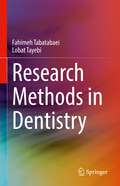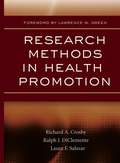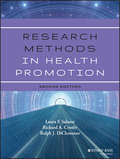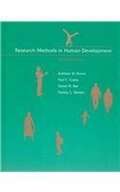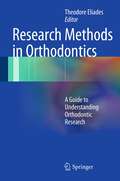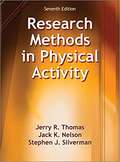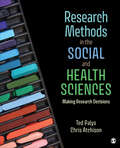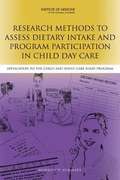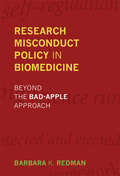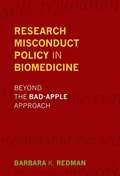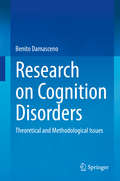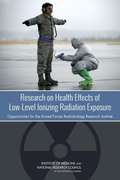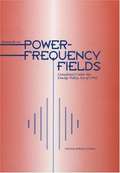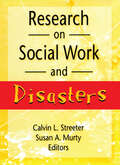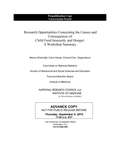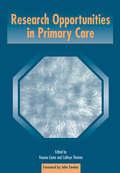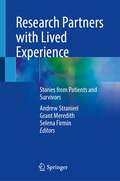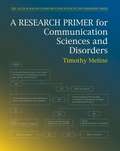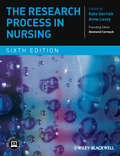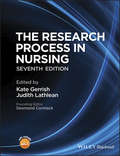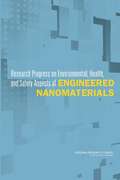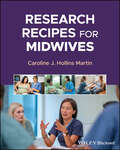- Table View
- List View
Research Methods in Dentistry
by Fahimeh Tabatabaei Lobat TayebiThis classroom-tested textbook will assist dental students with their academic research activities and help them to be competitive in today’s fast-growing research environment. It is designed as a core text for dental school classes such as Research Methodology and Scientific and Technical Writing, as well as Responsible Conduct of Research (RCR) training, but will also be a valuable resource for students and researchers in related fields, such as the medical sciences and biomedical engineering. The authors start the book by explaining key concepts and common approaches in dental research, both in basic science and clinical dentistry. They then familiarize readers with evidence-based research in dentistry and how to write a systematic review, explain the process of designing and presenting a proposal, discuss reporting results both in scientific and clinical research, and cover ethics in research, highlighting the significance of adherence to ethics both in animal as well as human studies.
Research Methods in Health Promotion
by Richard A. Crosby Ralph J. Diclemente Laura F. SalazarResearch Methods in Health Promotion provides students (advanced undergraduate and graduate students) and practitioners with basic knowledge and skills regarding the design, implementation, analysis, and interpretation of research in the field of health promotion. Taking the perspective that research involves a predetermined series of well-defined steps, the book presents these steps in a sequential format.
Research Methods in Health Promotion
by Laura F. Salazar Richard A. Crosby Ralph J. DiClementeThe bestselling textbook to understanding health research, updated and expanded Research Methods in Health Promotion provides students and practitioners with essential knowledge and skills regarding the design, implementation, analysis, and interpretation of research in the field of health promotion. Now in its second edition, this bestselling textbook has been updated with more recent research methodologies and additional information on sampling, participatory and survey research, and qualitative data analysis. The entire research process is covered, with specific points relating to both qualitative and quantitative research. By breaking the daunting process of research into simple and well-defined steps, this user-friendly text encourages students to think about research as a sequential process and provides explanations that facilitate better understanding of each step in the research process. A separate set of chapters cover the more quantitative methodological areas including designs, measurement, sampling, and data analysis in depth, giving readers the understanding they need to apply in practice. This book also provides applied chapters that illustrate the practical aspects of the research process, along with other critical information including grant writing and scientific writing. Evaluate the ethics, design, analysis, and interpretation of research Identify and understand the key components of research studies Analyze and interpret the results of experimental and survey research designs Understand the process of publishing a research report and constructing a grant proposal Research Methods in Health Promotion is ideal for both undergrad and graduate methods courses in health promotion and public health.
Research Methods in Human Development
by Paul C. Cozby Kathleen Brown Daniel W. KeeThis introductory text is designed for applied research methods courses focused on human development. Accessible and clearly written, the text reflects an interdisciplinary, life-span approach as well as a complete balance between experimental and non-experimental methods.
Research Methods in Orthodontics
by Theodore EliadesThe orthodontic literature includes many articles on basic science and engineering research techniques, but clinicians are typically unfamiliar with the principles underlying these techniques and may also lack the background knowledge required for a full appreciation of their role. This book comprehensively reviews a wide array of the research methods most frequently encountered in the literature, encompassing the areas of materials science and clinical and biological research. The various methods and techniques are carefully described, and their indications and limitations are explained. All of the information is up to date, reflecting latest developments in the field. For practicing professionals, Research Methods in Orthodontics will be an ideal introduction to instrumental analysis and basic science research methods. It will also serve as an excellent reference guide for researchers.
Research Methods in Physical Activity
by Jerry R. Thomas Jack K. Nelson Stephen J. SilvermanResearch Methods in Physical Activity, Seventh Edition, systematically guides students through the research process, introducing methods and tools specifically for kinesiology and exercise science disciplines, including the subdisciplines of physical therapy, rehabilitation, and occupational therapy. The seventh edition leads students and novice researchers to research competency with the distinctive humor that has become a trademark of this internationally recognized text. <P><P> This text provides step-by-step information for every aspect of the research process, from identifying and devising research questions to analyzing data and compiling results for presentation. Methods for qualitative, quantitative, and mixed-methods research approaches are addressed, and real-world research questions—including historical, experimental, epidemiological, and philosophical—are presented by scholarly contributors who give suggestions for approaches to follow. Photos, anecdotes, and humorous stories are used throughout the text to put students at ease and emphasize key points through practical applications. Enhancements to the seventh edition include the following: • Updated information and techniques for electronic searches to ensure students use best research practices • New information on meta-analysis and the benefits of journal-style writing that teach readers to evaluate and prepare data for scholarly journals and publication • Special attention to ethical issues to help readers understand the regulations involved in using human and animal subjects • New information on logistic regression that aids in the understanding of complex ideas • Further explanation of qualitative and mixed-methods research approaches, in addition to quantitative approaches, to ensure readers use the most appropriate methodology for their research <P><P> The content of the seventh edition maintains and expands upon the logical content progression that has made Research Methods in Physical Activity the leading text in the field. <P><P> Part I presents an overview of the research process, including problem development, preparation of the research plan, and understanding ethical issues in research and writing. Part II introduces statistical and measurement issues in research, and part III presents various types of or approaches to research and methodology from expert researchers in the field. Part IV includes a writing guide for result findings and details how to develop and organize research papers and presentations. Statistical tables and guides are available in the appendix. <P><P> To aid instructors, Research Methods in Physical Activity, Seventh Edition, includes a suite of ancillary materials featuring an instructor guide, test package, an extra data set for instructors who wish to create specialized learning activities, and presentation package plus image bank. <P><P> Research Methods in Physical Activity, Seventh Edition, instills in students the confidence to devise, collect, analyze, and present their research in a competent manner by systematically guiding them through the research process. It is an essential text for all emerging researchers in physical activity.
Research Methods in the Social and Health Sciences: Making Research Decisions
by Ted Palys Chris AtchisonResearch Methods in the Social and Health Sciences: Research Decisions, by Ted Palys and Chris Atchison, gives students a thorough, thoughtful, and highly readable introduction to the entire research process from start to finish. From its underlying premise that your research questions and objectives, rather than any specific method, should guide your research, this book discusses each step of the research process, from limiting the scope of a literature review to navigating ethical considerations to deciding which methods are best suited for finding answers to specific research questions to how to analyze data and present findings. Readers are encouraged to think deeply about each step of the research process. The book promotes this deliberation by discussing the strengths and limitations of different methods and. Throughout the process, the authors provide many examples from their own and student research, sharing insights for research decisions arising from that experience. Readers will develop the skills to create solid research questions, perform literature reviews, identify appropriate data sources and methods, conduct research, analyze and interpret data and translate the resulting knowledge generated from the research process to a wider audience– all core parts of the research process –by developing their knowledge and creating confidence in their own decision-making skills. After explaining the unique and often complementary strengths of qualitative and quantitative methods, students focus on what methods are best suited for finding answers to the research questions that interest them. Major types of research including experiments, case studies, surveys, quasi-experiments, ethnographies, focus groups, participatory action research, and archival studies all receive significant coverage. The text illustrates how these methods are enhanced by integrating them with 21st century technologies and combining them in mixed methods projects. Chapters on constructing a research proposal and disseminating research bookend the process with concrete steps in between to support students designing their own original research projects. Study questions at the end of each chapter encourage students to think critically about the research process and how the choices a researcher makes will broaden or constrain what they can find. By the end of the text, social and health science students will feel confident in undertaking ethical and thoughtful research.
Research Methods in the Social and Health Sciences: Making Research Decisions
by Ted Palys Chris AtchisonResearch Methods in the Social and Health Sciences: Research Decisions, by Ted Palys and Chris Atchison, gives students a thorough, thoughtful, and highly readable introduction to the entire research process from start to finish. From its underlying premise that your research questions and objectives, rather than any specific method, should guide your research, this book discusses each step of the research process, from limiting the scope of a literature review to navigating ethical considerations to deciding which methods are best suited for finding answers to specific research questions to how to analyze data and present findings. Readers are encouraged to think deeply about each step of the research process. The book promotes this deliberation by discussing the strengths and limitations of different methods and. Throughout the process, the authors provide many examples from their own and student research, sharing insights for research decisions arising from that experience. Readers will develop the skills to create solid research questions, perform literature reviews, identify appropriate data sources and methods, conduct research, analyze and interpret data and translate the resulting knowledge generated from the research process to a wider audience– all core parts of the research process –by developing their knowledge and creating confidence in their own decision-making skills. After explaining the unique and often complementary strengths of qualitative and quantitative methods, students focus on what methods are best suited for finding answers to the research questions that interest them. Major types of research including experiments, case studies, surveys, quasi-experiments, ethnographies, focus groups, participatory action research, and archival studies all receive significant coverage. The text illustrates how these methods are enhanced by integrating them with 21st century technologies and combining them in mixed methods projects. Chapters on constructing a research proposal and disseminating research bookend the process with concrete steps in between to support students designing their own original research projects. Study questions at the end of each chapter encourage students to think critically about the research process and how the choices a researcher makes will broaden or constrain what they can find. By the end of the text, social and health science students will feel confident in undertaking ethical and thoughtful research.
Research Methods to Assess Dietary Intake and Program Participation in Child Day Care: Workshop Summary
by Leslie PrayMore than 16 million children in the United States live in food-insecure households where they are unable to obtain enough food to meet their needs. At the same time, a growing number of children are overweight or obese. Because of these challenges, improving child nutrition has emerged as one of the nation's most urgent public health needs. The Child and Adult Care Food Program (CACFP), a U. S. Department of Agriculture (USDA) food program, served about 3. 3 million children in 2011, as well as more than 124,000 adults who require daily supervision or assistance. Since many children rely on CACFP for the majority of their daily food, the quality of foods provided has the potential to greatly improve the health of the children's diets. The USDA asked the IOM to review and recommend improvements, as necessary, to the CACFP meal requirements in order to keep them aligned with other federally funded food assistance programs and with the Dietary Guidelines for Americans. The 2011 IOM report, Child and Adult Care Food Program Aligning Dietary Guidance for All, reviewed the program in detail and provided recommendations for improvement. In February 2012, at the request of the USDA, the IOM conducted an additional workshop to examine research methods and approaches that could be used to design and conduct a nationally representative study assessing children's dietary intake and participation rates in child care facilities, including CACFP-sponsored child care centers and homes. Research Methods to Assess Dietary Intake and Program Participation in Child Day Care: Application to the Child and Adult Care Food Program Workshop Summary is the report that summarizes the workshop.
Research Misconduct Policy in Biomedicine: Beyond the Bad-Apple Approach (Basic Bioethics)
by Barbara K. RedmanAn analysis of current biomedical research misconduct policy that proposes a new approach emphasizing the context of misconduct and improved oversight.Federal regulations that govern research misconduct in biomedicine have not been able to prevent an ongoing series of high-profile cases of fabricating, falsifying, or plagiarizing scientific research. In this book, Barbara Redman looks critically at current research misconduct policy and proposes a new approach that emphasizes institutional context and improved oversight. Current policy attempts to control risk at the individual level. But Redman argues that a fair and effective policy must reflect the context in which the behavior in question is embedded. As journalists who covered many research misconduct cases observed, the roots of fraud “lie in the barrel, not in the bad apples that occasionally roll into view.” Drawing on literature in related fields—including moral psychology, the policy sciences, the organizational sciences, and law—as well as analyses of misconduct cases, Redman considers research misconduct from various perspectives. She also examines in detail a series of clinical research cases in which repeated misconduct went undetected and finds laxity of oversight, little attention to harm done, and inadequate correction of the scientific record. Study questions enhance the book's value for graduate and professional courses in research ethics.Redman argues that the goals of any research misconduct policy should be to protect scientific capital (knowledge, scientists, institutions, norms of science), support fair competition, contain harms to end users and to the public trust, and enable science to meet its societal obligations.
Research Misconduct Policy in Biomedicine
by Barbara K. RedmanFederal regulations that govern research misconduct in biomedicine have not been able to prevent an ongoing series of high-profile cases of fabricating, falsifying, or plagiarizing scientific research. In this book, Barbara Redman looks critically at current research misconduct policy and proposes a new approach that emphasizes institutional context and improved oversight. Current policy attempts to control risk at the individual level. But Redman argues that a fair and effective policy must reflect the context in which the behavior in question is embedded. As journalists who covered many research misconduct cases observed, the roots of fraud "lie in the barrel, not in the bad apples that occasionally roll into view." Drawing on literature in related fields -- including moral psychology, the policy sciences, the organizational sciences, and law -- as well as analyses of misconduct cases, Redman considers research misconduct from various perspectives. She also examines in detail a series of clinical research cases in which repeated misconduct went undetected and finds laxity of oversight, little attention to harm done, and inadequate correction of the scientific record. Study questions enhance the book's value for graduate and professional courses in research ethics.Redman argues that the goals of any research misconduct policy should be to protect scientific capital (knowledge, scientists, institutions, norms of science), support fair competition, contain harms to end users and to the public trust, and enable science to meet its societal obligations.
Research on Alcoholics Anonymous and Spirituality in Addiction Recovery
by Lee Anne Kaskutas Marc GalanterIt was once taken for granted that peer-assisted groups such as Alcoholics Anonymous had no "real" value in recovery from addiction. More recently, evidence-based medicine is recognizing a spiritual component in healing--especially when it comes to addiction. The newest edition of Recent Developments in Alcoholism reflects this change by focusing on the 12-step model of recovery as well as mindfulness meditation and other spiritually oriented activity. More than thirty contributors bring together historical background, research findings, and clinical wisdom to analyze the compatibility of professional treatment and nonprofessional support, day-to-day concepts of relapse prevention, the value of community building in recovery, and much more. Among the topics covered: (1) How and why 12-step groups work. (2) The impact of the spiritual on mainstream treatment. (3) The impact of AA on other nonprofessional recovery programs. (4) AA outcomes for special populations. (5) Facilitating involvement in 12-step programs. (6) Methods for measuring religiousness and spirituality in alcohol research. Whether one is referring clients to 12-step programs or seeking to better understand the process, this is a unique resource for clinicians and social workers. Developmental psychologists, too, will find Volume 18--Research on Alcoholics Anonymous and Spirituality in Addiction Recovery a worthy successor to the series.
Research on Cognition Disorders: Theoretical and Methodological Issues
by Benito DamascenoResearch on cognitive disorders is challenging due to the complexity of functions and numerous variables involved. The main purpose of this book is to effectively address the methodological issues and controversies in cognitive disorders research. First, it reviews the concept of human cognition as a complex activity involving interconnected mental and cerebral processes (its systemic structure), which represent the natural and social-cultural world by means of signs (its mediated, semiotic nature) and result from the internalization (or appropriation by the individual) of external actions and relations with things and persons (its cultural-historical origin). Subsequently, methodological issues are examined, including the use of the systemic and network approach in neuropsychological research, the concepts of single and double dissociation, single-case versus group studies, problems of brain-behavioral correlations using the lesion method and functional neuroimaging, the influence of task-relevant variables (confounders) related to the patient (e.g., age, education), to the lesion (size, etiology), and to the tests and testing conditions (ecological validity, examiner´s experience). Finally, readers are given the fundamentals of statistics applied to biomedical and psychological research, with illustrative examples of how to calculate Z score, effect size, χ2 test, t test, Pearson´s correlation coefficient, and simple linear regression. Methodological problems in current cognitive research on early multiple sclerosis, medial temporal lobe epilepsy, mild cognitive impairment and dementia are examined in detail.
Research on Health Effects of Low-Level Ionizing Radiation Exposure: Opportunities for the Armed Forces Radiobiology Research Institute
by Committee on Research Directions in Human Biological Effects of Low-Level Ionizing RadiationIt is probably only a matter of time before we witness the next event in which large numbers of people are exposed to ionizing radiation. In the past, planning a response to such an occurrence would have likely focused on the management of casualties from high-dose exposure. However, more recently, a different threat has come to the fore: accidental (through a containment breach in a nuclear power plant, for example) or intentional (via a "dirty bomb") releases of radioactivity resulting in low-dose exposure to a population. The magnitude of the health risks arising from low-dose radiation exposure is uncertain, and this uncertainty has significant economic implications for public health decision making. "Research on Health Effects of Low-Level Ionizing Radiation Exposure" examines recent scientific knowledge about the human effects of exposure to low-dose radiation from medical, occupational, and environmental ionizing-radiation sources. This report is intended to provide advice to the Armed Forces Radiobiology Research Institute (AFRRI) about its role in low-dose radiation health effects research. The report identifies current research directions in radiobiological science and assesses how AFRRI programs are advancing research along these directions. The recommendations of "Research on Health Effects of Low-Level Ionizing Radiation Exposure" will provide guidance for AFRRI to build on its strengths and advance its mission while contributing to the body of scientific knowledge on the health effects of exposure to low-dose ionizing radiation.
Research on Human Subjects: Problems of Social Control in Medical Experimentation
by Bernard Barber, John J. Lally, Julia Loughlin Makarushka and Daniel SullivanThe use of human subjects in biomedical research has increased rapidly with scientific discoveries. However, the failure to achieve the highest - or even adequate - standards of professional moral concern and behavior is a serious side effect. Research on Human Subjects is based on four years of intensive research in which two studies were completed - one on a nationally representative sample of biomedical research institutions, the second on a sample of 350 researchers who actually used human subjects. The authors explore prevalent ethical norms, the actual ethical behavior of scientists, and the dilemma between the values of humane therapy and scientific discovery. They document the inadequate training that biomedical researchers receive in the ethics of research on human subjects, not only in medical schools but in post-graduate training as well. This landmark work makes very specific suggestions for policy change and reform for the biomedical research profession and its employment of human subjects.
Research on Power-Frequency Fields: Completed Under the Energy Policy Act of 1992
by National Research CouncilA report on Research on Power-Frequency Fields
Research on Social Work and Disasters
by Calvin StreeterOver the past decade, several major natural disasters have had devastating impacts throughout the United States and the world. Since larger populations now live and work on land vulnerable to various hazards, natural disasters can be expected to affect more people each year. As a result, the social work profession soon will be stretched to its limi
Research Opportunities Concerning the Causes and Consequences of Child Food Insecurity and Hunger
by Division of Behavioral and Social Sciences and Education National Research Council Institute of Medicine Food and Nutrition Board Connie Citro Carol House Committee on National Statistics Nancy KirkendallSection 141 of The Healthy, Hunger-Free Kids Act of 20101 provides funding for a research program on the causes and consequences of childhood hunger and food insecurity, and the characteristics of households with childhood hunger and food insecurity, with a particular focus on efforts to improve the knowledge base regarding contributing factors, geographic distribution, programmatic effectiveness, public health and medical costs, and consequences for child development, well-being, and educational attainment. The Economic Research Service and Food and Nutrition Service of the US Department of Agriculture conducted two outreach efforts to obtain input from the research community and other stakeholders to help focus on areas and methods with the greatest research potential. First, Food and Nutrition Service sought written comments to selected questions through publication of a Federal Register Notice. The second option was to convene a workshop under the auspices of the Committee on National Statistics of the National Research Council and the Food and Nutrition Board of the Institute of Medicine. Research Opportunities Concerning the Causes and Consequences of Child Food Insecurity and Hunger is the summary of that workshop, convened in Fall 2012 to examine research gaps and opportunities to advance understanding of the causes and consequences of child hunger in the United States. This report reviews the adequacy of current knowledge, identifies substantial research gaps, and considers data availability of economic, health, social, cultural, demographic, and other factors that contribute to childhood hunger or food insecurity. It also considers the geographic distribution of childhood hunger and food insecurity; the extent to which existing federal assistance programs reduce childhood hunger and food insecurity; childhood hunger and food insecurity persistence, and the extent to which it is due to gaps in program coverage; and the inability of potential participants to access programs, or the insufficiency of program benefits or services. Research Opportunities Concerning the Causes and Consequences of Child Food Insecurity and Hunger will be a resource to inform discussions about the public health and medical costs of childhood hunger and food insecurity through its focus on determinants of child food insecurity and hunger, individual, community, and policy responses to hunger, impacts of child food insecurity and hunger, and measurement and surveillance issues.
Research Opportunities in Primary Care
by Yvonne Carter Kate Thomas'Medical technology is beneficial for well researched dangerous diseases. However, most symptoms that people bring to their primary care physician have no single clearly identifiable cause: investigations and drugs do more harm than good - and also waste resources - ' - Wilfrid Treasure Diagnosis and Risk Management in Primary Care teaches that adopting an evidence-based approach to primary care improves patient care and treatment outcomes. It demonstrates that brief clinical assessments, repeated if necessary, allow effective diagnosis while avoiding the costs and complications associated with more advanced testing. Adopting a fresh approach, this book sets consultation skills alongside evidence-based information by both itemising the specific techniques and facts that are needed in the consulting room, and providing detailed information on odds and likelihood ratios to quantify risk and deal with uncertainty. This book provides food for thought, and helps doctors develop communication skills that support their personal styles of consulting, encouraging a more traditional, intuitive treatment. It provides a map of the consultation and a compass to navigate through symptoms, signs and evidence - listening to their patients with one ear and, with the other, to the reflective inner voice of reason. General Practitioner Specialist Trainees and their teachers will find much of interest, as will established General Practitioners with an interest in maintaining traditional models of care. Undergraduate medical students and candidates for the MRCGP will find this an ideal reader for the clinical skills assessment. 'What a breath of fresh air to find an author capable of putting the patient back at the centre of the consultation and who is able to entertain at the same time as he informs and to stimulate critical reflection while nudging us in the direction of a rigorous approach to diagnosis, and the assessment and communication of risk.' From the foreword by Roger Jones
Research Partners with Lived Experience: Stories from Patients and Survivors
by Andrew Stranieri Grant Meredith Selena FirminThis book aims to foster collaborations between patients who have intense lived experience with a medical condition or family violence and researchers investigating them. Inviting patients or survivors into the research team is found to have significant advantages, and chapters review the literature on the benefits they can bring to investigative research teams. The collaboration can take place at multiple stages of research from helping to research design, participating in co-investigators, contributing to the interpretation of results, etc. The conditions addressed in this book include medical conditions from anxiety, postural orthostatic tachycardia syndrome, lupus, asthma, chronic kidney disease, etc. The authors are higher degree students, academics, and active research team members who share their experiences. This is be instrumental in helping patients and survivors decide whether to transition to research. It will also support research team leaders in determining how to benefit from the new perspectives researchers with lived experience bring. The personal narratives provide insight into the challenges and rewards of having lived experience while conducting research. This book is a valuable resource for researchers in clinical fields who have been touched by firsthand exposure to a condition and have been motivated to conduct research in the respective fields. The chapters will enrich understanding for adult patients and survivors and for parents of children suffering intense experiences, who engage with the latest research publications. It will also broaden the understanding of medical, biomedical, and health sciences students interested in reading the narrative accounts of patients and survivors. Readers will gain refreshing perspectives and insights. The book relates to patients managing all kinds of noncommunicable diseases or experiences of violence, and how they can share their valuable experiences into future advancementto research. It is related to SDG 3, good health and well-being.
A Research Primer For Communication Sciences And Disorders
by Timothy MelineA Research Primer for Communication Sciences and Disorders addresses the most current topics in research, presents them clearly for students and practitioners, focuses on getting research evidence into practice, directs students and instructors to additional resources, and provides many case examples and study questions. The book is ideal for face-to-face classroom teaching or distance-learning courses.
The Research Process in Nursing
by Anne Lacey Kate Gerrish'The perfect text for any health care professional who wishes to gain a sound understanding of research...This text succeeds where others fail in terms of the thoroughness of the research process and the accessible style in which the material is presented. In an age when nursing and health care research is going from strength to strength this book offers those in the world of academia and practice an excellent and essential 'bible' that is a must on any bookshelf'Dr Aisha Holloway, Lecturer Adult Health, Division of Nursing, The University of Nottingham'a book that helps you each step of the way. A very understandable and enjoyable publication'Accident and Emergency Nursing Journal 'key reference resource that students of research can use at various levels of study. It is comprehensive, user friendly and very easy to read and make sense of'Gillian E Lang, Amazon reviewerThe sixth edition of this book reflects significant developments in nursing research in recent years, ensuring the reader is provided with the very latest information on research processes and methods. It continues to explore how to undertake research as well as evaluating and using research findings in clinical practice, in a way that is suitable for both novice researchers and those with more experience.Divided into six sections, the chapters are ordered in a logical fashion that also allows the reader to dip in and out. The first two sections of the book provide a comprehensive background to research in nursing. The third section presents a variety of qualitative and quantitative approaches, both new and well-established. The final three sections then look at collecting and making sense of the resulting data and putting the research findings into clinical practice.Summarises key points at the start of each chapter to guide you throughIncludes contributions from a wide range of experts in the fieldAccessible but doesn't shrink away from complex debates and technical issuesNew to this edition:Accompanying website (www.wiley.com/go/gerrish)Ten completely new chapters including Narrative Research, Mixed Methods and Using Research in Clinical Practice'Research Example' boxes from a wide variety of research types
The Research Process in Nursing
by Judith Lathlean Kate GerrishComprehensive and thorough in scope, The Research Process in Nursing 7th edition provides everything you could want to know about research methods. This established textbook reflects the significant advances in nursing research and the importance of evidence-based practice, and provides an invaluable resource for both the novice and the more experienced researcher. It includes practical information and advice on: How to find and critique the evidence How to choose the right approach How to collect data How to make sense of the data How to put research into practice Special features: A clear, explicit and easy to understand text which links theory with practical steps in the research process. Examples provided allow the reader to apply a variety of research concepts to theoretical learning and professional practice. Incorporates chapters, research examples, and policy from a range of international countries, including Canada, Australia, USA and Hong Kong. Provides detailed discussions around each example, which clearly link theory with practice Easy to read for novice researchers and undergraduate nursing students, but at the same time provides sufficient depth and detail to be of value to experienced researchers and practitioners.
Research Progress on Environmental, Health, and Safety Aspects of Engineered Nanomaterials
by Committee to Develop a Research Strategy for Environmental Studies ToxicologyDespite the increase in funding for research and the rising numbers of peer-reviewed publications over the past decade that address the environmental, health, and safety aspects of engineered nanomaterials (ENMs), uncertainty about the implications of potential exposures of consumers, workers, and ecosystems to these materials persists. Consumers and workers want to know which of these materials they are exposed to and whether the materials can harm them. Industry is concerned about being able to predict with sufficient certainty whether products that it makes and markets will pose any environmental, health or safety issues and what measures should be taken regarding manufacturing practices and worldwide distribution to minimize any potential risk. However, there remains a disconnect between the research that is being carried out and its relevance to and use by decision-makers and regulators to make informed public health and environmental policy and regulatory decisions. "Research Progress on Environmental, Health, and Safety Aspects of Nanomaterials" evaluates research progress and updates research priorities and resource estimates on the basis of results of studies and emerging trends in the nanotechnology industry. This report follows up the 2012 report "A Research Strategy for Environmental, Health, and Safety Aspects of Engineered Nanomaterials," which presented a strategic approach for developing the science and research infrastructure needed to address uncertainties regarding the potential environmental, health, and safety risks posed by ENMs. This new report looks at the state of nanotechnology research, examines market and regulatory conditions and their affect on research priorities, and considers the criteria for evaluating research progress on the environmental, health, and safety aspects of nanotechnology.
Research Recipes for Midwives
by Caroline J. Hollins MartinResearch Recipes for Midwives A 16-step guide to writing a research proposal Development of a research question, identification of a research method, and working through the steps to build a sample are complex and hugely important stages in the career of a student midwife. A good research ‘recipe’—a specific method geared to address a certain kind of question—can be critical to the creation of a successful proposal. Research Recipes for Midwives offers a selection of thoroughly tested research methods from which student midwives can choose in developing their own projects, expertly directing the reader through a 16-step process for applying a ‘recipe’ to their own proposal. Reader will also find: Information regarding the relationship between midwifery research and practice A thorough introduction to research methods built around clear concepts Tools for making a complex and challenging process manageable and exciting Research Recipes for Midwives is the ideal resource for student midwives developing research proposals, particularly those enrolled in research methods modules, providing readers with an edge in this foundational element of the research process.
